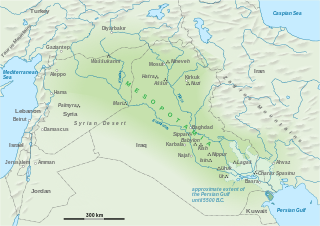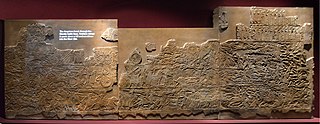This article needs additional citations for verification .(December 2009) |
This article concerns the period 649 BC – 640 BC.
Contents
| Millennium |
|---|
| 1st millennium BC |
| Centuries |
| Decades |
| Years |
| Categories |
This article needs additional citations for verification .(December 2009) |
This article concerns the period 649 BC – 640 BC.
| Millennium |
|---|
| 1st millennium BC |
| Centuries |
| Decades |
| Years |
| Categories |

Chaldea was a small country that existed between the late 10th or early 9th and mid-6th centuries BC, after which the country and its people were absorbed and assimilated into the indigenous population of Babylonia. Semitic-speaking, it was located in the marshy land of the far southeastern corner of Mesopotamia and briefly came to rule Babylon. The Hebrew Bible uses the term כשדים (Kaśdim) and this is translated as Chaldaeans in the Greek Old Testament, although there is some dispute as to whether Kasdim in fact means Chaldean or refers to the south Mesopotamian Kaldu.

The 7th century BC began the first day of 700 BC and ended the last day of 601 BC.
The 8th century BC started the first day of 800 BC and ended the last day of 701 BC. The 8th century BC was a period of great change for several historically significant civilizations. In Egypt, the 23rd and 24th dynasties lead to rule from Kingdom of Kush in the 25th Dynasty. The Neo-Assyrian Empire reaches the peak of its power, conquering the Kingdom of Israel as well as nearby countries.

Babylonia was an ancient Akkadian-speaking state and cultural area based in the city of Babylon in central-southern Mesopotamia. It emerged as an Akkadian populated but Amorite-ruled state c. 1894 BC. During the reign of Hammurabi and afterwards, Babylonia was retrospectively called "the country of Akkad", a deliberate archaism in reference to the previous glory of the Akkadian Empire. It was often involved in rivalry with the older ethno-linguistically related state of Assyria in the north of Mesopotamia and Elam to the east in Ancient Iran. Babylonia briefly became the major power in the region after Hammurabi created a short-lived empire, succeeding the earlier Akkadian Empire, Third Dynasty of Ur, and Old Assyrian Empire. The Babylonian Empire rapidly fell apart after the death of Hammurabi and reverted to a small kingdom centered around the city of Babylon.
The year 640 BC was a year of the pre-Julian Roman calendar. In the Roman Empire, it was known as year 114 Ab urbe condita. The denomination 640 BC for this year has been used since the early medieval period, when the Anno Domini calendar era became the prevalent method in Europe for naming years.

Elam was an ancient civilization centered in the far west and southwest of modern-day Iran, stretching from the lowlands of what is now Khuzestan and Ilam Province as well as a small part of southern Iraq. The modern name Elam stems from the Sumerian transliteration elam(a), along with the later Akkadian elamtu, and the Elamite haltamti. Elamite states were among the leading political forces of the Ancient Near East. In classical literature, Elam was also known as Susiana, a name derived from its capital Susa.

Ashurbanipal was the king of the Neo-Assyrian Empire from 669 BC to his death in 631. He is generally remembered as the last great king of Assyria. Ashurbanipal inherited the throne as the favored heir of his father Esarhaddon; his 38-year reign was among the longest of any Assyrian king. Though sometimes regarded as the apogee of ancient Assyria, his reign also marked the last time Assyrian armies waged war throughout the ancient Near East and the beginning of the end of Assyrian dominion over the region.

The history of Mesopotamia ranges from the earliest human occupation in the Paleolithic period up to Late antiquity. This history is pieced together from evidence retrieved from archaeological excavations and, after the introduction of writing in the late 4th millennium BC, an increasing amount of historical sources. While in the Paleolithic and early Neolithic periods only parts of Upper Mesopotamia were occupied, the southern alluvium was settled during the late Neolithic period. Mesopotamia has been home to many of the oldest major civilizations, entering history from the Early Bronze Age, for which reason it is often called a cradle of civilization.

The Battle of the Ulai River, also known as the Battle of Til-Tuba or the Battle of Tulliz, in c. 653 BCE, was a battle between the invading Assyrians, under their king Ashurbanipal, and the kingdom of Elam, which was a Babylonian ally. The result was a decisive Assyrian victory. Teumman, the king of Elam, and his son Tammaritu were killed in the battle.

The conquest of Elam by the Neo-Assyrian Empire took place between 655 and 639 BC.

The ancient Near East was the home of early civilizations within a region roughly corresponding to the modern Middle East: Mesopotamia, ancient Egypt, ancient Persia, Anatolia and the Armenian highlands, the Levant and the Arabian Peninsula. The ancient Near East is studied in the fields of ancient Near East studies, Near Eastern archaeology, and ancient history.

The Sargonid dynasty was the final ruling dynasty of Assyria, ruling as kings of Assyria during the Neo-Assyrian Empire for just over a century from the ascent of Sargon II in 722 BC to the fall of Assyria in 609 BC. Although Assyria would ultimately fall during their rule, the Sargonid dynasty ruled the country during the apex of its power and Sargon II's three immediate successors Sennacherib, Esarhaddon and Ashurbanipal are generally regarded as three of the greatest Assyrian monarchs. Though the dynasty encompasses seven Assyrian kings, two vassal kings in Babylonia and numerous princes and princesses, the term Sargonids is sometimes used solely for Sennacherib, Esarhaddon and Ashurbanipal.

Humban-haltash III or Umanaldash was the last major ruler of Elam. He was defeated and captured by the Assyrian king Ashurbanipal.

Teumman was a king of the ancient kingdom of Elam, ruling it from 664 to 653 BCE, contemporary with the Assyrian king Ashurbanipal. In various sources, the name may be found spelled as Te’umman, Teumann, or Te-Umman. For a time, "many scholars, beginning with G.G. Cameron," believed him to have been the Tepti-Huban-Inshushinak mentioned in inscriptions, although this view has since fallen from favor.

Ummanigash was briefly a ruler in the ancient kingdom of Elam, ruling after the beheading of his predecessor Teumman in 653. He ruled part of Elam while his brother, Tammaritu, ruled another. He is also referred to as Humban-nikash II and Khumban-nikash II.
Tammaritu II was the ruler of Elam from 652 until 650 or 649 BC. After the brief reigns of Indabibi and Humban-haltash III, Tammaritu II was briefly restored to power in 648. Tammaritu II was the son of Tammaritu I and the successor of Ummanigash, his uncle.
Indabibi was a ruler of ancient Elam in 649 BCE and perhaps 648. He is sometimes referred to as Indabigash. He was the successor of Tammaritu II and the predecessor of Humban-Haltash III. Elam was located to the east of the more powerful Assyrian Empire, and the reign of Indabibi occurred during the reign of Assyrian king Ashurbanipal.

Tammaritu I, son of Urtak, was briefly a ruler in the ancient kingdom of Elam, ruling after the beheading of his predecessor Teumman in 653. He ruled part of Elam while his brother, Ummanigash, ruled another.

Tammaritu was a prince of Elam and son of Teumman, king of the ancient kingdom of Elam, who ruled from 664 to 653 BCE, and was a contemporary with the Assyrian king Ashurbanipal. In various sources, the name may be found spelled as Te’umman, Teumann, or Te-Umman. For a time, "many scholars, beginning with G.G. Cameron," believed him to have been the Tepti-Huban-Inshushinak mentioned in inscriptions, although this view has since fallen from favor.